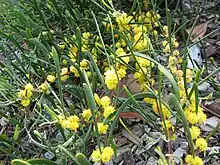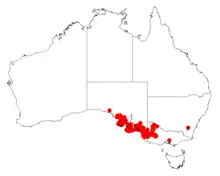| Mealy wattle | |
|---|---|
 | |
| Scientific classification | |
| Kingdom: | Plantae |
| Clade: | Tracheophytes |
| Clade: | Angiosperms |
| Clade: | Eudicots |
| Clade: | Rosids |
| Order: | Fabales |
| Family: | Fabaceae |
| Subfamily: | Caesalpinioideae |
| Clade: | Mimosoid clade |
| Genus: | Acacia |
| Species: | A. farinosa |
| Binomial name | |
| Acacia farinosa | |
 | |
| Occurrence data from AVH | |
| Synonyms | |
|
Racosperma farinosa Pedley | |
Acacia farinosa, commonly known as mealy wattle, is a shrub that is endemic to Australia.[2] It grows to between 1 and 2 metres high and has ascending phyllodes.[2] The yellow globular flower heads generally appear between August and October in its native range.[3] These are followed by curled and twisted pods which are up to 6 cm long and 2–3 mm wide.[2]
The species was formally described by English botanist John Lindley in 1838 from material collected on Thomas Mitchell's expedition near Lake Charm, Victoria in 1836.[1] The description was published in Mitchell's Three Expeditions into the interior of Eastern Australia. The name Acacia whanii F.Muell. ex Benth. has been misapplied to this species.[1]
The species occurs naturally in shrubland and woodland in South Australia and Victoria.[2] It often occurs in association with Eucalyptus incrassata and Melaleuca uncinata.[3]
Cultivation
The species may be used as a groundcover in coastal areas.[3]
References
- 1 2 3 "Acacia farinosa". Australian Plant Name Index (APNI), IBIS database. Centre for Plant Biodiversity Research, Australian Government, Canberra. Retrieved 2009-09-17.
- 1 2 3 4 "Acacia farinosa". World Wide Wattle. Retrieved 2009-09-17.
- 1 2 3 "Acacia farinosa". Electronic Flora of South Australia Fact Sheet. State Herbarium of South Australia. Retrieved 2009-09-17.
External links
- Three Expeditions into the Interior of Eastern Australia, Volume 1 by Mitchell at Project Gutenberg
- Three Expeditions into the Interior of Eastern Australia, Volume 2 by Mitchell at Project Gutenberg